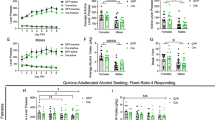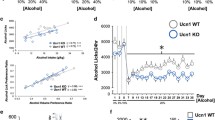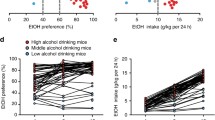Abstract
Rationale
There is accumulating evidence that the neuropeptide urocortin 1 (Ucn1) is involved in alcohol consumption. Thus far, however, most studies have been performed in mice.
Objectives
The purpose of the present study was to characterize Ucn1 expression in rats selectively bred for either high or low alcohol intake.
Methods
Brains from naive male rats of five pairs of independently selected lines (iP/iNP, AA/ANA, HARF/LARF, HAD1/LAD1, and HAD2/LAD2) were analyzed by immunohistochemistry.
Results
Significant differences were found between iP/iNP, HARF/LARF, and HAD2/LAD2 in number of Ucn1-containing cells in the Edinger–Westphal (EW) nucleus (the main source of Ucn1 in the brain), whereas no significant differences were found between HAD1/LAD1 and AA/ANA. Similarly, significant differences in the optical density of Ucn1 immunoreactivity in EW were found between iP/iNP, HARF/LARF, and HAD2/LAD2, whereas no differences on this measure were found between HAD1/LAD1 and AA/ANA. In the lateral septum (LS, the main projection area of Ucn1-containing neurons in the rat), significant differences were found only between AA/ANA and HAD2/LAD2; however, a meta-analysis indicated that across all five lines, preferring animals had a significantly greater number of Ucn1-positive fibers than nonpreferring animals.
Conclusions
These results provide evidence that, in rats, Ucn1 may be involved in regulation of alcohol intake, and that this regulation may occur through the Ucn1 projections to LS.




Similar content being viewed by others
References
Bachtell RK, Wang Y-M, Freeman P, Risinger FO, Ryabinin AE (1999) Alcohol drinking produces brain region-selective changes in expression of inducible transcription factors. Brain Res 847:157–165
Bachtell RK, Tsivkovskaia NO, Ryabinin AE (2002) Strain differences in urocortin expression in the Edinger–Westphal nucleus and its relation to alcohol-induced hypothermia. Neurosci 113:421–434
Bachtell RK, Weitemier AZ, Galvan-Rosas A, Tsivkovskaia NO, Risinger FO, Phillips TJ, Grahame NJ, Ryabinin AE (2003) The Edinger–Westphal-lateral septum urocortin pathway and its relationship to alcohol consumption. J Neurosci 15:2477–2487
Bachtell RK, Weitemier AZ, Ryabinin AE (2004) Lesions of the Edinger–Westphal nucleus in C57BL/6J mice disrupt ethanol-induced hypothermia and ethanol consumption. Eur J Neurosci 20:1613–1623
Bale TL, Vale WW (2004) CRF and CRF receptors: role in stress responsivity and other behaviors. Annu Rev Pharmacol Toxicol 44:525–557
Becker BJ (1994) Combining significance levels. In: Cooper H, Hedges LV (eds) The handbook of research synthesis. Russell Sage, New York, pp 215–230
Bittencourt JC, Vaughan J, Arias C, Rissman RA, Vale WW, Sawchenko PE (1999) Urocortin expression in rat brain: evidence against a pervasive relationship of urocortin-containing projections with targets bearing type 2 CRF receptors. J Comp Neurol 415:285–312
Cavani JA, Reiner A, Cuthbertson SL, Bittencourt JC, Toledo CA (2003) Evidence that urocortin is absent from neurons of the Edinger–Westphal nucleus in pigeons. Braz J Med Biol Res 36:1695–1700
Chang SL, Patel NA, Romero AA (1995) Activation and desensitization of Fos immunoreactivity in the rat brain following ethanol administration. Brain Res 679:89–98
Crabbe JC, Phillips TJ, Kosobud A, Belknap JK (1990) Estimation of genetic correlation: interpretation of experiments using selectively bred and inbred animals. Alcohol Clin Exp Res 14:141–151
Czachowski CL, Samson HH (2002) Ethanol- and sucrose-reinforced appetitive and consummatory responding in HAD1, HAD2, and P rats. Alcohol Clin Exp Res 26:1653–1661
Ehlers CL, Chaplin RI, Wall TL, Lumeng L, Li TK, Owens MJ, Nemeroff CB (1992) Corticotropin releasing factor (CRF): studies in alcohol preferring and non-preferring rats. Psychopharmacol 106:359–364
Iovino M, Steardo L (1985) Thirst and vasopressin secretion following central administration of angiotensin II in rats with lesions of the septal area and subfornical organ. Neuroscience 15:61–67
Klooster J, Beckers HJM, Vrensen GFJM, VanderWant JJL (1993) The peripheral and central projections of the Edinger–Westphal nucleus in the rat. A light and electron microscopic tracing study. Brain Res 632:260–273
Kozicz T, Yanaihara H, Arimura A (1998) Distribution of urocortin-like immunoreactivity in the central nervous system of the rat. J Comp Neurol 391:1–10
Lê AD, Israel Y, Juzytsch W, Quan B, Harding S (2001) Genetic selection for high and low alcohol consumption in a limited-access paradigm. Alcohol Clin Exp Res 25:1613–1620
Lodge DJ, Lawrence AJ (2003) The CRF1 receptor antagonist antalarmin reduces volitional ethanol consumption in isolation-reared fawn-hooded rats. Neuroscience 117:243–247
McBride WJ, Li TK (1998) Animal models of alcoholism: neurobiology of high alcohol-drinking behavior in rodents. Crit Rev Neurobiol 12:339–369
Milner PM (1991) Brain-stimulation reward: a review. Can J Psychol 45:1–36
Murphy JM, Stewart RB, Bell RL, Badia-Elder NE, Carr LG, McBride WJ, Lumeng L, Li TK (2002) Phenotypic and genotypic characterization of the Indiana University rat lines selectively bred for high and low alcohol preference. Behav Genet 32:363–388
Paxinos G, Watson C (1998) The rat brain in stereotaxic coordinates. Academic, London
Ryabinin AE, Criado JR, Henricksen SJ, Bloom FE, Wilson MC (1997) Differential sensitivity of c-Fos expression in hippocampus and other brain regions to moderate and low doses of alcohol. Mol Psychiatry 2:32–43
Ryabinin AE, Bachtell RK, Heinrichs SC, Lee S, Rivier C, Olive MF, Mehmert KK, Camarini R, Kim JA, Koenig HN, Nannini MA, Hodge CW, Roberts AJ, Koob GF (2002) The corticotropin-releasing factor/urocortin system and alcohol. Alcohol Clin Exp Res 26:714–722
Ryabinin AE, Galvan-Rosas A, Bachtell RK, Risinger FO (2003) High alcohol/sucrose consumption during dark circadian phase in C57BL/6J mice: involvement of hippocampus, lateral septum and urocortin-positive cells of the Edinger–Westphal nucleus. Psychopharmacol 165:296–305
Sheehan TP, Chambers RA, Russell DS (2004) Regulation of affect by the lateral septum: implications for neuropsychiatry. Brain Res Rev 46:71–117
Sokal RR, Rohlf FJ (1995) Biometry. Freeman, San Francisco, pp 794–797
Szczepanska-Sadowska E, Sadowski B, Sobocinska J (1981) Enhancement of osmotic thirst elicited by electric stimulation of the limbic system in dogs. J Physiol 77:671–674
Taghzouti K, Simon H, Tazi A, Dantzer R, Le Moal M (1985) The effect of 6-OHDA lesions of the lateral septum on schedule-induced polydipsia. Behav Brain Res 15:1–8
Topple AN, Hunt GE, McGregor IS (1998) Possible neural substrates of beer-craving in rats. Neurosci Lett 252:99–102
Valdez GR, Roberts AJ, Chan K, Davis H, Brennan M, Zorrilla EP, Koob GF (2002) Increased ethanol self-administration and anxiety-like behavior during acute ethanol withdrawal and protracted abstinence: regulation by corticotropin-releasing factor. Alcohol Clin Exp Res 26:1494–1501
Vasconcelos LA, Donaldson C, Sita LV, Casatti CA, Lotfi CF, Wang L, Cadinouche MZ, Frigo L, Elias CF, Lovejoy DA, Bittencourt JC (2003) Urocortin in the central nervous system of a primate (Cebus apella): sequencing, Immunohistochemical, and hybridization histochemical characterization. J Comp Neurol 463:157–175
Vasudev R, Gentil CG, Covian MR (1985) Taste preferences in a free-choice situation following electrical stimulation and lesion of septal area in rats. Physiol Behav 34:619–624
Vaughan J, Donaldson C, Bittencourt J, Perrin MH, Lewis K, Sutton S, Chan R, Turnbull AV, Lovejoy D, Rivier C, Rivier J, Sawchenko PE, Vale W (1995) Urocortin, a mammalian neuropeptide related to fish urotensin I and to corticotropin-releasing factor. Nature 378:287–292
Warwick RB (1954) The ocular parasympathetic nerve supply and its mesencephalic sources. J Anat 88:71–93
Weitemier AZ, Ryabinin AE (2004) Repeated alcohol exposure regulates urocortin I innervation of the lateral septum and dorsal raphe in mice. Alcohol Clin Exp Res 28:5(Suppl):56A
Weitemier AZ, Woerner A, Backstrom P, Hyytia P, Ryabinin AE (2001) Expression of c-Fos in Alko alcohol rats responding for ethanol in an operant paradigm. Alcohol Clin Exp Res 25:704–710
Weninger SC, Dunn AJ, Muglia LJ, Dikkes P, Miczek KA, Swiergiel AH, Berridge CW, Majzoub JA (1999) Stress-induced behaviors require the corticotropin-releasing hormone (CRH) receptor, but not CRH. Proc Natl Acad Sci U S A 96:8283–8288
Wolf FM (1986) Meta-analysis: quantitative methods for research synthesis. Sage University Press, Hollywood, CA, pp 18–19
Acknowledgements
The authors would like to thank Adam Weitemier for valuable technical assistance with the study and Dr. John Belknap for help with the statistical analyses.
This work was supported by NIH grants AA10760, AA13738 (A.E.R.), and AA13108 (A.D.L.).
Author information
Authors and Affiliations
Corresponding author
Rights and permissions
About this article
Cite this article
Turek, V.F., Tsivkovskaia, N.O., Hyytia, P. et al. Urocortin 1 expression in five pairs of rat lines selectively bred for differences in alcohol drinking. Psychopharmacology 181, 511–517 (2005). https://doi.org/10.1007/s00213-005-0011-x
Received:
Accepted:
Published:
Issue Date:
DOI: https://doi.org/10.1007/s00213-005-0011-x




